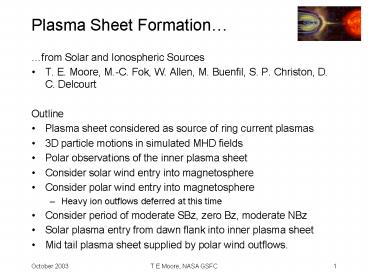Plasma Sheet Formation - PowerPoint PPT Presentation
1 / 20
Title:
Plasma Sheet Formation
Description:
Plasma sheet considered as source of ring current plasmas ... Cusp more tailward, joining plasmasheet? October 2003. T E Moore, NASA GSFC. 16. NBz in 3D ... – PowerPoint PPT presentation
Number of Views:49
Avg rating:3.0/5.0
Title: Plasma Sheet Formation
1
Plasma Sheet Formation
- from Solar and Ionospheric Sources
- T. E. Moore, M.-C. Fok, W. Allen, M. Buenfil, S.
P. Christon, D. C. Delcourt - Outline
- Plasma sheet considered as source of ring current
plasmas - 3D particle motions in simulated MHD fields
- Polar observations of the inner plasma sheet
- Consider solar wind entry into magnetosphere
- Consider polar wind entry into magnetosphere
- Heavy ion outflows deferred at this time
- Consider period of moderate SBz, zero Bz,
moderate NBz - Solar plasma entry from dawn flank into inner
plasma sheet - Mid tail plasma sheet supplied by polar wind
outflows.
2
Motivation and Model Setup
- Solar Wind
- 400 km/s, Bz -2nt,
- Random starting points, velocities, within limits
- Polar Wind
- 10 km/s, ILAT gt 55
- Random starting points, velocities, within limits
- MHD Magnetic Field (LFM)
- Example trajectories
- Tilt possible but zero here
- Trajectory code adapted from Delcourt e.g. 1993
- Given MHD self-consistent fields, realistic solar
wind interaction, what kinetic behavior is
expected? - How does solar wind enter?
- How does polar wind outflow participate in global
circulation? - Compare with Richard, Walker, Peroomian e.g.
April 2003 GRL - Include minimal ionospheric outflow from polar
wind
3
MHD SBz Fields
4
Prevalent Solar Wind Entry Path
5
The Solar-Polar Wind Density (xy plane)
- Relative density plots for solar wind particles
(upper) - Relative density plots for polar wind particles
(lower) - Complementarity of two patterns is evident
6
Solar Polar Wind Pressure (xy plane)
- Polar wind dominates the central plasma sheet
region. - Solar and Polar wind contributions comparable in
pressure in the inner magnetosphere or ring
current region
7
Solar Polar Wind Pressure (xz plane)
- Polar Wind dominates the lobes and plasma sheet
proper - Polar and Solar wind contributions to inner
magnetosphere are comparable in pressure.
8
Solar Polar Wind Pressure (yz plane)
- Complementary orthogonal view.
9
SBz in 3D(Solar Wind)
- Bow shock/sheath
- Empty plasma sheet
- Dawn entry region
- Feeds ring current
10
SBz in 3D(Polar Wind)
- Low pressure lobes
- Plasmasheet
- Ring current region
- Mantle and LLBL
11
Parallel motions (pitch angle in xz)
- Solar wind lands beyond the X line in the
simulation. - Polar wind straddles the X line and fills the
plasma sheet earthward of it. - Lobe - plasma sheet - lobe structure contains
layers of antisunward, sunward streams as
observed. - Plasma sheet isotropization is weak here.
12
Simulated Velocity Distributions
- Consider a set of bins at X30, Y0, and Z
running from 3 to -3 Re - Each bin contains 100 particles, all from the
polar wind outflows. - Clear symmetric pattern emerges,
- Cold polar wind inflows toward the neutral sheet
- Hot accelerated outflows away from the neutral
sheet - Z-2.5 Z-1.5 Z-0.5
Z0.5 Z1.5 Z2.5 Re
13
Polar Observations of Plasma Sheet
14
MHD NBz Fields
15
NBz in 3D (Solar Wind)
- Tail cavity smaller
- Ring current cavity larger
- Cusp more tailward, joining plasmasheet?
16
NBz in 3D(Polar Wind)
- Plasma sheet extended in X, narrow in Y
- Ring current still forms
- High latitude outfllows form polar plume owing to
high latitude reconnection - Similar to Winglee 1998.
17
Conclusions
- Full single particle motions in MHD fields allow
tracking of solar and polar wind contributions to
magnetospheric plasmas. - Some problems with energy conservation can be
dealt with using smaller time step, finer MHD
field grid. - For SBz, solar wind enters principally on the
dawn flank, creating a weak? ring current
without any paths through the plasma sheet
proper. - For SBz, polar wind fills the plasma sheet
proper, and supplies a comparable pressure of
plasma in the inner plasma sheet or ring current
region. - Simulated flow features in the plasma sheet
proper are in good agreement with observations of
cold lobal wind filling of the plasma sheet. - For NBz, similar solar entry occurs, but solar
wind ring current is weaker and farther out from
Earth than the polar wind ring current.
18
Back Up Charts
19
The Solar Polar Wind Density (xz plane)
- Relative density plots for solar wind particles
(upper) - Relative density plots for polar wind particles
(lower) - Note! Color bars are different and emphasize
Polar Wind. - Inner magnetosphere contributions are comparable
for Polar and Solar Wind. - Complementarity of two patterns is evident
20
The Solar Polar Wind Density (yz plane)
- Relative density plots for solar wind particles
(left) - Note magnetosheath, empty lobes, empty
plasmasphere - Relative density plots for polar wind particles
(right) - Note full lobes, leakage into magnetosheath,
outer plasma trapping.































